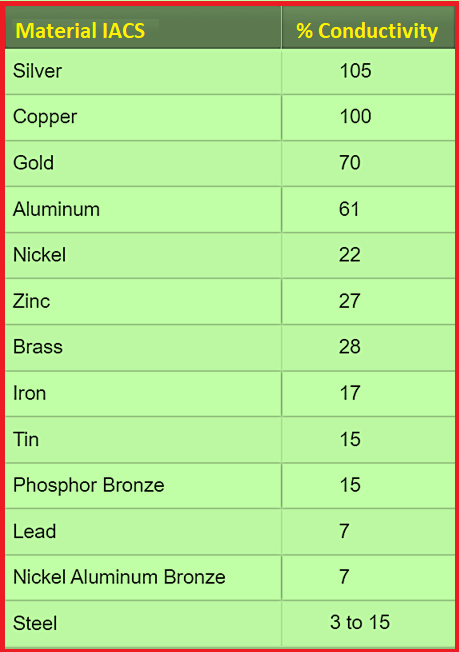All Aluminum Alloy conductors (AAAC) are made out of high-strength Aluminum-Magnesium-Silicon alloy. As compared to conventional ACSR, AAAC conductors are of lighter weight, comparable strength and current carrying capacity, lower electrical losses, and superior corrosion resistance.
For the above peculiar properties, AAAC has a wide acceptance in the Distribution and Transmission lines.

AAAC conductor’s conductivity is expressed in IACS.
What is IACS here?
IACS is the abbreviation for International Annealed Copper Standard and the number preceding “IACS” is the percentage of conductivity a material has relative to copper, which is considered to be 100% conductive.
For example, All Aluminum Alloy conductors (AAAC) have a minimum conductivity of 52.5% IACS. That means this conductor has 52.5% conductivity relative to copper.

The electrical conductivity of various materials used in electrical products is compared with Copper conductivity. In electrical materials, it is common practice that substitutes brass or bronze for copper in electrical applications. Brass is only 28% as conductive as copper. Some bronzes are as low as 7% as conductive as copper.
Copper is the standard by which electrical materials are rated and conductivity ratings are expressed as a relative measurement of copper. These ratings will frequently be expressed as IACS. This does not mean that copper has no resistance (is 100% conductive in an absolute sense), but rather that it is the standard by which other materials are measured. The higher the % IACS, the more conductive the material is.
This standard refers to a pure, “standard” copper having a resistivity of 1.7241 microhm-cm at 20°C (68°F).
All Aluminum Alloy Conductors (AAAC) Features:
• High strength-to-weight ratio
• Better Sag Characteristics
• Improved Electrical Properties
• Excellent resistance to corrosion
Construction of All Aluminum Alloy Conductors (AAAC):
AAAC conductors are available in several compositions. There are several series conductors available.
In the figure below, Aluminum Alloy 6201 Wires, are concentrically stranded over a central wire of Aluminum 6201.

Here 6201 is the Series of Aluminum tells about the composition of materials used.
6000 Series Aluminum Alloys:
Composition of AAAC Conductors: Al-Mg-Si
Containing manganese and silicon, 6000 series aluminum’s structure allows the alloy to be solution heat-treated which improves the strength of the material.
Alloys in this group have magnesium and silicon as the major alloying elements. They are moderate-strength alloys that are achieved by either heat treating or cold working. For a heat-treatable grade, they have an excellent spot and fusing weldability and can be furnace brazed. They can be easily anodized.
Applications of 6000 Series Aluminum Alloys:
6201 Aluminum Alloy:
- Fuses, Electrical conductors
AAAC Conductors are generally made out of aluminum alloy 6201.
6061 Aluminum Alloy:
- Heavy-duty structures requiring good corrosion resistance, railroad cars, bridges, pipelines, aerospace, truck and marine, storage tanks, furniture
6063 Aluminum Alloy:
- Architectural applications – windows, doors, storefronts, trim items, furniture, pipe railings
6082 Aluminum Alloy:
- High-stress applications, Trusses, Bridges, Cranes, Transport applications, Ore skips, Beer barrels, Milk churns
7000 Series Aluminum Alloys:
Composition: Al-Zn-Mg-Cu
Alloys in this series have the highest strength of all the series. Zinc is the primary alloying addition. These alloys have excellent fatigue properties. High strength as well as lightweight compared to steel.
Alloys in series can be spot welded but not fusion welded. They are prone to localized corrosion forms and especially to stress corrosion cracking (SCC).
If corrosion is a concern, these alloys should be anodized, primed, painted, or protected with some type of chemical film.
The highest strength of all commercially available aluminum (alloying with Zn, Mg, and Cu, known as the super hardness aluminum)
Applications of 7000 Series Aluminum Alloys:
- Due to poor conductivity (at max 36.71 IACS %) 7000 Series Aluminum alloys are not suitable for making conductors.
7005 Aluminum Alloy:
- 7005 Aluminum Alloy alloys with zinc and magnesium, offer excellent stress resistance and weldability, though it has the lowest strength among the 7000 series alloys.
It is used in manufacturing consumer electronics or sporting goods, such as laptop shells, mobile phone cases, baseball bats, golf clubs, and more.
7050 Aluminum Alloy:
- 7050 Aluminum Alloy alloys with zinc, magnesium, and copper, and features a strength slightly below 7075 due to its lower copper content. Its corrosion resistance is higher than 7075 and its magnesium content is also high.
It is used in aerospace industries for fuselages, medium and thick plane plates, ribs, rivets, and other aircraft components.
7075 Aluminum Alloy:
- 7075 Aluminum Alloy alloys with zinc, magnesium, and copper, and features excellent plasticity and corrosion resistance. It is one of the strongest in the 7000 series and maintains its strength, even at low temperatures.
It is used in manufacturing items that need high strength and corrosion resistance, such as the skin, rivets, panels, frames, and stringers of aircraft as well as baseball bats, ski poles, and other sports equipment.



